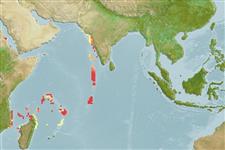>
Gobiiformes (Gobies) >
Gobiidae (Gobies) > Gobiinae
Etymology: Trimma: Greek, trimma, -atos = something crushed (Ref. 45335); dalerocheila: From the Greek daleros for hot or fiery, and cheilos for lip, in allusion to the fiery red snout and lips of this species (Ref. 46430).
More on author: Winterbottom.
Environment: milieu / climate zone / depth range / distribution range
Ecología
marino demersal; rango de profundidad 3 - 48 m (Ref. 46430), usually 20 - 40 m (Ref. 46430). Tropical
Distribución
Países | Áreas FAO | Ecosistemas | Ocurrencias, apariciones | Point map | Introducciones | Faunafri
Western Indian Ocean: Chagos Archipelago.
Tamaño / Peso / Age
Maturity: Lm ? range ? - ? cm
Max length : 2.0 cm SL macho / no sexado; (Ref. 46430)
Espinas dorsales (total): 7; Radios blandos dorsales (total): 9-11; Espinas anales 1; Radios blandos anales: 7 - 11; Vértebra: 26. Brick-red in color, usually with two paler bars (one across pectoral base, the other centered on the space between the two dorsal fins); snout and chin fiery red, broken by two pale horizontal stripes from the dorsal and ventral margins of the pupil, respectively. The dorsal stripe passes anteriorly across the nostrils, the ventral stripe crosses the upper jaw and may continue onto the chin (Ref. 46430).
Collected from lagoons as well as from oceanic drop-offs (Ref. 46430). Forms schools and feeds on plankton (Ref. 46430).
Life cycle and mating behavior
Madurez | Reproducción | Puesta | Huevos | Fecundidad | Larva
Winterbottom, R., 1984. A review of the gobiid fish genus Trimma from the Chagos Archipelago, central Indian Ocean, with the description of seven new species. Can. J. Zool. 62 (4):695-715. (Ref. 46430)
IUCN Red List Status (Ref. 130435)
Threat to humans
Harmless
Human uses
Más información
PaísesÁreas FAOEcosistemasOcurrencias, aparicionesIntroduccionesStocksEcologíaDietacomponentes alimenticiosconsumo de alimentoRación
Nombres comunesSinónimosMetabolismoDespredadoresEcotoxicologíaReproducciónMadurezPuestaAgregación para la puestaFecundidadHuevosEgg development
Age/SizeCrecimientoLength-weightLength-lengthLength-frequenciesMorfometríaMorfologíaLarvaDinámica larvariaReclutamientoAbundanciaBRUVS
ReferenciasAcuiculturaPerfil de acuiculturaRazasGenéticaElectrophoresesheritabilidadEnfermedadesProcesamientoNutrientsMass conversion
ColaboradoresImágenesStamps, Coins Misc.SonidosCiguateraVelocidadTipo de nataciónSuperficie branquialOtolitosCerebrosVisión
Herramientas
Special reports
Download XML
Fuentes de Internet
Estimates based on models
Preferred temperature (Ref.
123201): 18.9 - 28.2, mean 26.8 °C (based on 12 cells).
Phylogenetic diversity index (Ref.
82804): PD
50 = 0.5000 [Uniqueness, from 0.5 = low to 2.0 = high].
Bayesian length-weight: a=0.01023 (0.00477 - 0.02194), b=3.02 (2.84 - 3.20), in cm total length, based on LWR estimates for this (Sub)family-body shape (Ref.
93245).
Resiliencia (Ref.
120179): Alto, población duplicada en un tiempo mínimo inferior a 15 meses (Preliminary K or Fecundity.).
Fishing Vulnerability (Ref.
59153): Low vulnerability (10 of 100).
